 |
 |
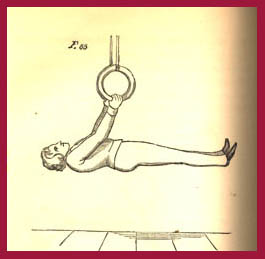
 During the 19th century and much
of the first half of the 20th century the word gymnastics
described many activities, including horizontal bar, parallel bars,
horse, and still rings, but also weight lifting, yoga, group
calisthenics, indian club juggling, human pyramid building, pole
vaulting, rope, pole, or ladder climbing, etc. - forms of exercise
unrelated to the modern sport
of gymnastics.
During the 19th century and much
of the first half of the 20th century the word gymnastics
described many activities, including horizontal bar, parallel bars,
horse, and still rings, but also weight lifting, yoga, group
calisthenics, indian club juggling, human pyramid building, pole
vaulting, rope, pole, or ladder climbing, etc. - forms of exercise
unrelated to the modern sport
of gymnastics. 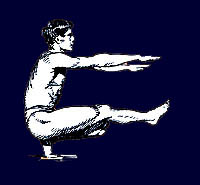
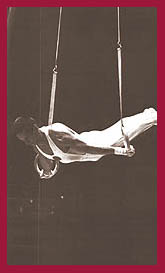
Climbing: A Natural Gymnastics . . . 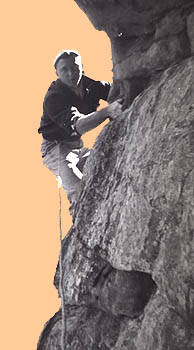 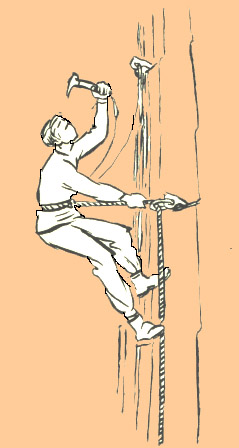 The
1950s saw a subtle change in the perception of rock climbing, a
sport having its origins almost three-quarters of a century earlier as
an extension of hiking. The
1950s saw a subtle change in the perception of rock climbing, a
sport having its origins almost three-quarters of a century earlier as
an extension of hiking. Bill Taylor, Georgia 1954 >
Comparing highly publicized, and gracefully executed artistic gymnastics routines with elegant performances of top climbers on difficult rock pitches led some to conclude that climbing was less an extension of hiking, and more a form of natural gymnastics. Furthermore, it would seem that artistic gymnasts had achieved higher skill levels and strengths than had climbers. Of course, most rock climbers of the time avoided philosophical conjectures about the nature of their activity, and simply climbed, influenced by the climbing feats of the previous generation - a comparison with gymnastics was not on the radar screen. .
. .
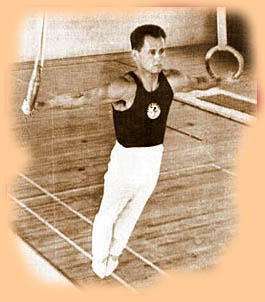 Gymnasts
pressed themselves to do the most difficult stunts in their routines ("C" level
at that time), practicing until they reached
perfection. If climbers were
to cultivate similar strengths and adopt this attitude of
intensive practice - particularly on short outcrops or boulders -
standards of difficulty would surely rise. Gymnasts
pressed themselves to do the most difficult stunts in their routines ("C" level
at that time), practicing until they reached
perfection. If climbers were
to cultivate similar strengths and adopt this attitude of
intensive practice - particularly on short outcrops or boulders -
standards of difficulty would surely rise. Richard Beckner 1956
Sporadically over the years prior to WWII certain individuals and small groups within the climbing community had approached their sport with a vigorous gymnastic attitude - notably the 'Bleausards in the 1930s. Now, a post-war generation would carry this concept into the future. .
. .
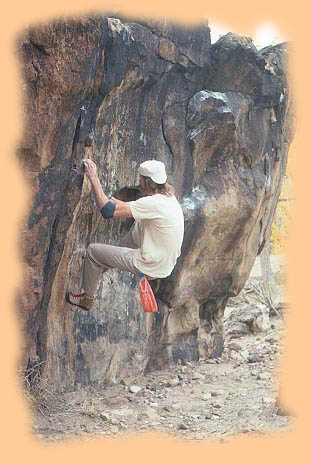 By
the late 1960s rock climbing, treated more as gymnastics and less as
extreme hiking, had acquired a more athletic aura, illuminating the
humor in remarks such as:
"Strength
is not important to climbing. Rushing,
scrabbling or muscling up are merely dangerous"
- Climbing in Britain,
by J. E. Q. Barford
(1947).
In the years that have followed, young and talented
boulderers and rock climbers - performing essentially as gymnasts on
natural apparatus - have pushed standards to amazing levels. By
the late 1960s rock climbing, treated more as gymnastics and less as
extreme hiking, had acquired a more athletic aura, illuminating the
humor in remarks such as:
"Strength
is not important to climbing. Rushing,
scrabbling or muscling up are merely dangerous"
- Climbing in Britain,
by J. E. Q. Barford
(1947).
In the years that have followed, young and talented
boulderers and rock climbers - performing essentially as gymnasts on
natural apparatus - have pushed standards to amazing levels.Jim Holloway 1970s |
| Page 1.1 | Climbing Activities in Early Gymnastics. GutsMuths and Jahn. First Turnplatz. |
| Page 1.1a | Jahn's Climbing Structures: Einbaum, Zweibaum, Bierbaum, Kimmel. |
| Page 1.2 | Hasenheide Turnplatz. Basel Turnplatz. |
| Page 1.3 | Ladders in Gymnastics & Climbing : 1700s to 2004 and Beyond. |
| Page 1.4 | Masts, Poles, and Ropes. Old Harvard Gym. Dynamics. Early Women's Gymnastics. |
| Page 1.5 | 19th Century Turnplatz Illustrations. |
| Page 1.6 | 19th Century Military Gymnastics Illustrations. |
| Page 1.7 | Military Gymnastics - an Early Climbing Wall. Acrobats of the Early 1800s & Chuck Pratt. |
| Page 1.8 | The Late Victorians - Climbing & Gymnastics. Karl Prusik's Gymnastik fur Bergsteiger. |
| Page 1.9 | Demise of Gymnastic Climbing Events. Competitive Rope Climbing: History & Analysis. |
| Page 2.0 | The Still Rings: Brief History, Rating Structure, Personal Involvement. |
| Page 2.1 | Several Notable Rock Climbers who were Gymnasts. |